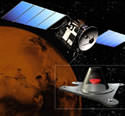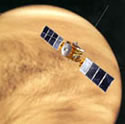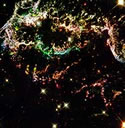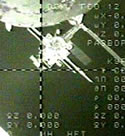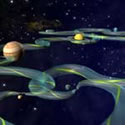
Image credit: NASA
NASA Astronomer Martin Lo has worked out what he believes is a series of low energy flight paths that spacecraft can take to minimize they fuel they need to move around our solar system. Each planet and moon have five points near them where gravity balances out, called Lagrange points – by networking them together, Lo has worked out paths which will use very little fuel to travel from planet to planet. The first spacecraft to take advantage his work will be NASA’s Genesis mission, which will collect solar particles and then return them back to Earth.
A “freeway” through the solar system resembling a vast array of virtual winding tunnels and conduits around the Sun and planets, as envisioned by an engineer at NASA’s Jet Propulsion Laboratory, Pasadena, Calif., can slash the amount of fuel needed for future space missions.
Called the Interplanetary Superhighway, the system was conceived by Martin Lo, whose software was used to help design the flight path for NASA’s Genesis mission, which is currently using this “freeway in space” on its mission to collect solar wind particles for return to Earth.
Most missions are designed to take advantage of the way gravity pulls on a spacecraft when it swings by a body such as a planet or moon. Lo’s concept takes advantage of another factor, the Sun’s pull on the planets or a planet’s pull on its nearby moons. Forces from many directions nearly cancel each other out, leaving paths through the gravity fields in which spacecraft can travel.
Each planet and moon has five locations in space called Lagrange points, where one body’s gravity balances another’s. Spacecraft can orbit there while burning very little fuel. To find the Interplanetary Superhighway, Lo mapped some possible flight paths among the Lagrange points, varying the distance the spacecraft would go and how fast or slow it would travel. Like threads twisted together to form a rope, the possible flight paths formed tubes in space. Lo plans to map out these tubes for the whole solar system.
Lo’s research is based on theoretical work begun in the late nineteenth century by the French mathematician Henri Poincar?. In 1978, NASA’s International Sun-Earth Explorer 3 was the first mission to use low energy orbits around a Lagrange point. Later, using low energy paths between Earth and the Moon, controllers at NASA’s Goddard Space Flight Center, Greenbelt, Md., sent the spacecraft to the first encounter with a comet, Comet Giacobini-Zinner, in 1985.
In 1991, another method of analyzing low energy orbits was used by engineers from JPL and the Japanese Space Agency to enable the Japanese Hiten mission to reach the Moon. Inspired by this pioneering work and research conducted by scientists at the University of Barcelona, Lo conceived the theory of the Interplanetary Superhighway.
Lo and his colleagues have turned the underlying mathematics of the Interplanetary Superhighway into a tool for mission design called “LTool,” using models and algorithms developed at Purdue University, West Lafayette, Ind. The new LTool was used by JPL engineers to redesign the flight path for the Genesis mission to adapt to a change in launch dates. Genesis launched in August 2001.
The flight path was designed for the spacecraft to leave Earth and travel to orbit the Lagrange point. After five loops around this Lagrange point, the spacecraft will fall out of orbit without any maneuvers and then pass by Earth to a Lagrange point on the opposite side of the planet. Finally, it will return to Earth’s upper atmosphere to drop off its samples of solar wind in the Utah desert.
“Genesis wouldn’t need to use any fuel at all in a perfect world,” Lo said. “But since we can’t control the many variables that occur throughout the mission, we have to make some corrections as Genesis completes its loops around a Lagrange point of Earth. The savings on the fuel translates into a better and cheaper mission.”
Lo added, “This concept does not guarantee easy access to every part of the solar system. However, I can envision a place where we might construct and service science platforms around one of the Moon’s Lagrange points. Since Lagrange points are landmarks for the Interplanetary Superhighway, we might be able to shunt spacecraft to and from such platforms.” A team at NASA’s Johnson Space Center, Houston, working with the NASA Exploration Team, proposes to someday use the Interplanetary Superhighway for future human space missions.
“Lo’s work has led to breakthroughs in simplifying mission concepts for human and robotic exploration beyond low-Earth orbit,” said Doug Cooke, manager of Johnson’s Advanced Development Office. “These simplifications result in fewer space vehicles needed for a broad range of mission options.”
The work on the Interplanetary Superhighway for space mission design was nominated for a Discover Innovation Award by Discover magazine editors and an outside panel of experts.
JPL is managed for NASA by the California Institute of Technology, Pasadena. For more information on the Genesis mission, visit the Internet at: http://www.genesismission.org/.
Original Source: NASA/JPL News Release
